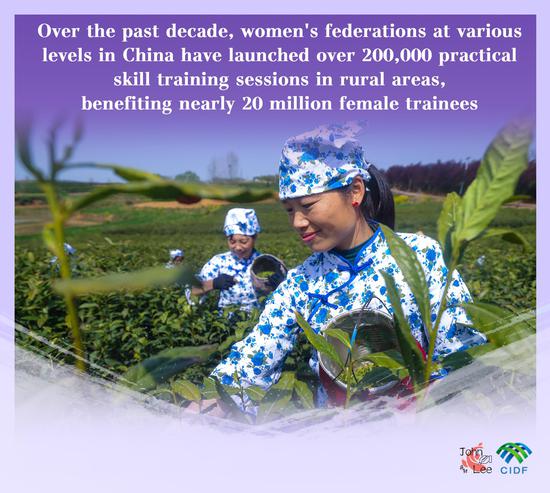
A woman shows banknotes and coins included in the 2019 edition of the fifth series of the renminbi. (Photo/Xinhua)
China's "Big Six" State-owned commercial banks measured by assets have announced a surge in loans to customers across the board in the first three quarters of this year, amid strengthened efforts to stabilize the overall economy.
"In pursuing economic growth, we must continue to focus on the real economy," said the report to the 20th National Congress of the Communist Party of China, delivered on Sunday. In response, large State-owned commercial banks said they will further increase support for the real economy in their next steps.
Industrial and Commercial Bank of China has introduced a series of measures and policy instruments, increased resource allocation and credit supply, and maintained rapid growth of credit volume. It released more than 5 trillion yuan ($694.25 billion) of new investments and financing into the real economy in the first three quarters through various means, including loans and bond investments, said the bank in an announcement released on the Shanghai Stock Exchange on Monday.
By the end of September, the balance of ICBC's domestic renminbi loans had increased by 2.2 trillion yuan compared to the end of the previous year. The growth was 457.3 billion yuan more than that of the same period last year.
The bank also optimized the credit structure and improved the accuracy and directness of credit funding. As of Sept 30, its balance of loans in the manufacturing industry recorded an increase of more than 810 billion yuan, or 37.5 percent, from the end of last year.
Its balance of loans to strategic emerging industries exceeded 1.6 trillion yuan, up 59.2 percent over the same period. Its green loans increased by about 950 billion yuan or 34 percent from the beginning of this year.
China Construction Bank Corp also increased credit supply by focusing on key areas and weak links in the national economy. At the end of September, the bank's loans denominated in RMB amounted to nearly 20 trillion yuan, an increase of 2.1 trillion yuan from the end of last year. The growth was nearly 520 billion yuan greater compared with that of the same period last year.
The resource allocation structure of CCB was further optimized. By the end of September, its loans to manufacturing reached 2.2 trillion yuan, up 32 percent from the end of last year, serving economic transformation and upgrading, and the high-quality development of the manufacturing industry. The balance of loans to infrastructure sectors was 5.66 trillion yuan, rising nearly 580 billion yuan over the same period.
Its balance of residential mortgages was 6.5 trillion yuan, an increase of 110 billion yuan from the end of last year, strongly supporting rigid and improving housing demands. In addition, the bank proposed to contribute 30 billion yuan to the establishment of a housing rental fund to explore a new model of real estate development that encourages both housing rentals and purchases, said CCB.
Bank of China has introduced 42 measures in eight aspects to support the real economy. The lender continuously strengthened financing support for key areas, and improved the efficiency of credit approval and granting.
By the end of the third quarter, its customer loans increased by 1.69 trillion yuan or 10.78 percent from the beginning of the year to 17.41 trillion yuan.
Agricultural Bank of China and Bank of Communications announced their total RMB loans increased by 2.2 trillion yuan and 644.4 billion yuan, respectively, in the first three quarters. Postal Savings Bank of China also said its total loans to customers reached 7.15 trillion yuan at the end of the third quarter, up 10.81 percent from the previous year-end.
"The Chinese banking sector has proactively responded to policies aiming to stabilize the economy and continuously intensified efforts to assist enterprises in overcoming difficulties. It increased credit supply to ensure targeted support for the real economy and consolidate the foundation of economic recovery," said Shao Ke, senior researcher with the BOC Research Institute.


















































 京公网安备 11010202009201号
京公网安备 11010202009201号